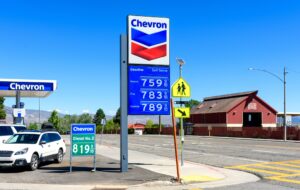
California leads the nation in more ways than one — taxes, regulations, and, once again, gas prices. As of mid-May 2025, the average gasoline price in California is $4.85 per gallon, far above the national average of $3.26, according to GasBuddy and AAA.
And it’s getting worse. A March 2025 study by USC Professor Michael Mische forecasts California’s fuel prices could spike 75 percent to over $8 per gallon within the next year. That’s not hyperbole — that’s the trajectory unless policymakers reverse course.
The culprit? It’s not oil companies or global demand. It’s decades of state-level tax hikes, regulatory overreach, and misguided climate mandates that have warped the gasoline market in California. This is a man-made problem — a case study in government failure, not market failure.
What Really Drives Gas Prices
According to the US Energy Information Administration (EIA), gasoline prices are generally shaped by five components: crude oil prices, refining costs, distribution and marketing, taxes, and regulations. In California, taxes and regulatory costs alone account for more than $1.30 per gallon — nearly double the national average.
California has the highest gas tax in the country, at $0.678 per gallon, not including additional fees and environmental surcharges. Add in the Cap-and-Trade program, the Low Carbon Fuel Standard (LCFS), and boutique fuel blends that are required only in California, and it becomes clear why Californians pay more.
And things are deteriorating further. The Mische study warns that with refinery closures due to hostile permitting processes and low expected returns under California’s climate mandates, fuel supply in the state could drop by 20 percent by 2026, even as demand stays relatively stable. Fewer refineries and rigid fuel standards will mean tighter supply and higher prices.
Texas vs. California: A Tale of Two Fuel Markets
To see how bad California’s policies are, look no further than Texas. As of May 2025, Texas drivers pay about $3.00 per gallon, nearly two dollars less than Californians. Texas levies a combined state gasoline tax of just $0.20 per gallon, and its regulatory structure is streamlined and energy-friendly.
Texas refineries aren’t subject to California’s carbon credit system or forced to produce costly special-blend fuels. And because it allows for a more competitive and open fuel market, the state benefits from both lower wholesale prices and more efficient distribution. The difference is stark — and instructive.
The Fallacy of “Green” Fuel Mandates
Supporters of California’s approach claim high prices are a necessary cost for fighting climate change. But what if those policies aren’t actually working?
California’s greenhouse gas emissions have declined, but much of the reduction has come from cleaner electricity generation, not gasoline policies. Meanwhile, low-income and working-class Californians are being punished at the pump while driving older, less fuel-efficient vehicles.
This amounts to a regressive tax that hurts the very people politicians claim to protect. Worse, these rules don’t reduce global emissions — they just push energy production and refining out of the state and overseas, often to countries with weaker environmental standards.
The Economic Cost of Fragmented Fuel Policies
In my academic work, including a peer-reviewed paper and subsequent research (SSRN profile), I’ve documented how state-level fragmentation of fuel markets — through taxes, environmental programs, and infrastructure restrictions — creates costly inefficiencies that drive up prices.
These policies discourage new investment in refining and fuel transportation. They create artificial shortages. And they increase transaction costs that ultimately fall on consumers.
In short, California’s model is a textbook case of how overregulation and government micromanagement destroy affordability without delivering proportional benefits.
What Should Be Done Instead?
The answer isn’t new subsidies or “green” credits. It’s not banning gas-powered cars or rationing vehicle miles. The solution is to embrace free-market capitalism and the principles Milton Friedman championed: let prices reflect market conditions, not bureaucratic preferences.
That means:
- Repealing California’s Cap-and-Trade and LCFS programs.
- Standardizing fuel blends to match those used nationwide.
- Halting the gasoline tax increases scheduled under current law.
- Encouraging private investment in refining and fuel infrastructure.
The federal government could help by streamlining interstate pipeline permitting and revisiting federal environmental rules that duplicate or exacerbate state mandates. But the real change must come from Sacramento.
Conclusion: A Crisis of Policy, Not Price
California’s high gas prices aren’t the product of global volatility or greedy corporations. They’re the result of a long series of deliberate policy choices that make fuel harder to produce, harder to transport, and harder to afford.
When government picks winners and losers in energy markets, consumers lose. And when politicians mistake control for competence, they create systems that serve ideology rather than reality.
It’s time to abandon the myth that high gas prices are the price of progress. California has created a man-made fuel crisis — and only free-market reforms can solve it.
